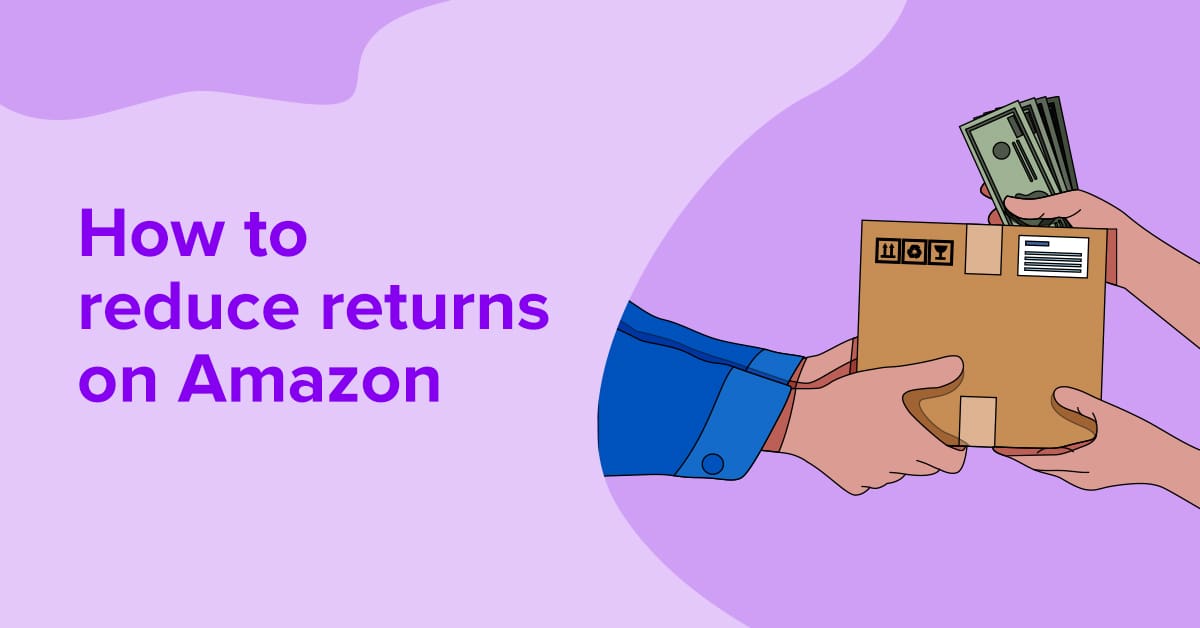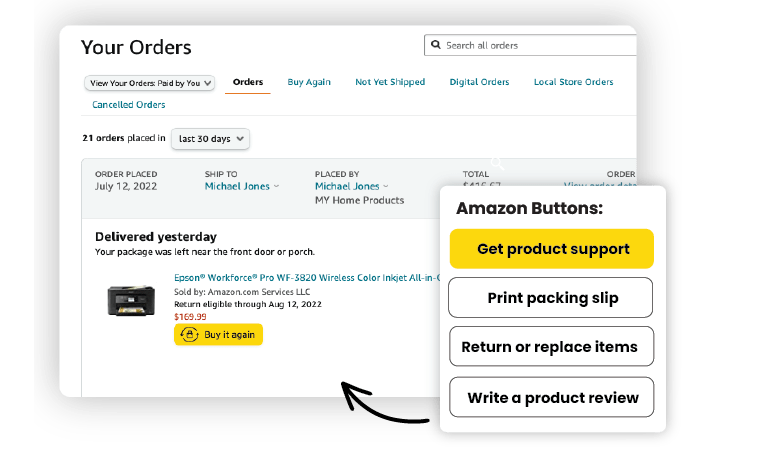
How to Reduce Amazon Returns

This is a guest post from Isaac Hadriye, President & CEO of OnSite Support.
Providing a smooth buyer’s journey is an arduous task for Amazon sellers, and returns only add to the complexity. They can result in lost revenue, especially if you can’t resell the item. This is particularly problematic for merchants who sell products with low profit margins. You also have to contend with additional costs like return shipping expenses and Amazon’s refund fees, which can quickly add up and hurt your bottom line.
Through internal research, we found it takes three new sales to make up for each order that’s returned, and with average eCommerce return rates ranging from 20% to 30%, Amazon merchants face potentially huge revenue loss. Preventing returns in the first place is your best defense, as it helps you preserve inventory and maintain a healthy store reputation. We’ll walk you through specific strategies that can turn these minuses into lucrative pluses.
How to minimize returns for your Amazon store
To limit the number of returns you receive on the marketplace, adopt a comprehensive approach consisting of the following tactics.
Include accurate product descriptions and images
One of the most common reasons for returns on Amazon is inaccurate product descriptions and misleading images.
As a buyer, there’s nothing worse than receiving something in the mail and realizing it’s completely different from what you expected. If the discrepancy between what’s on your product listing and what the customer holds in their hand is too great, they’ll likely return it.
Each product listing should be detailed and accurate, with all relevant information clearly laid out, including its uses, dimensions, color, material, technical specifications, compatibility with other products, and even limitations. Also, feature high-quality images and videos from multiple angles to set realistic expectations for customers.
If your item comes in various versions, highlight any differences between each option. If you sell clothes, include a size guide so customers can measure themselves and make the right selection — clothes that don’t fit are certain to be sent back.
Remember, with online shopping, customers are unable to see or feel the item before they buy, so you have to make it as easy as possible for them to understand what they’re buying.
Create engaging videos
People are more likely to purchase if they can see a video of the product in use. Static images are helpful, but being able to show how a product works with movement gives a better idea of what they’re buying. Cover multiple angles and use cases so the customer has all the information they need to make a decision.
Keep in mind, however, that you can only include videos if you’re a registered brand on Amazon.
Display a clear and easy-to-understand return policy
It may be counterintuitive, but having an easy, no-hassle returns policy goes a long way toward reducing returns because it establishes customers’ trust in you from the start. Customers may avoid you if they know stringent requirements limit their ability to return items. Having a “free returns” option, however, lets them know you care about making them happy.
Concretely outline your return policy on your product listings, including the time frame, the product conditions required for a return to be accepted, and the refund process.
Provide excellent customer service
Lackluster customer service virtually guarantees you’ll experience more returns. Make sure you address every complaint quickly and efficiently. People want to feel their concerns matter, so actively listen to their issues and keep consumers informed of the actions you take. That white-glove service can change their minds before they pull the trigger. Beyond preventing returns, the quality of your customer service can also turn a negative experience into a positive one and thus reinforce brand loyalty.
Provide better technical and quality support by establishing an open, well-structured communication channel with your customers. This allows you to drill down into each buyer’s specific issue and take corrective measures. Sometimes, returns are due to incomplete or inaccurate product information, while in other cases, consumers may require a replacement due to defects, or outright refuse to accept orders if the packaging is damaged. Clear communication is imperative to identify these problems and remedy them correctly.
Another key component of satisfactory customer service is having robust product support for Amazon. Onsite can build a customized landing page for your business where customers can go directly from their order page and find all kinds of resources to help them troubleshoot their purchase letting them hopefully sort their issue before having to return anything.

“Get product support” button directly on Amazon orders
Conduct quality control checks
One of the most effective ways to prevent returns is to perform quality control checks on products before they’re shipped to customers. This entails inspecting for defects, ensuring items are properly packaged, and verifying they meet the specifications outlined in the product listing.
Whether you handle your fulfillment through FBA or a third-party provider, it’s crucial to ensure you haven’t received a bad batch from suppliers and avoid shipping any defective units.
If you use FBA, you can book inspections to make sure everything meets the program’s requirements and that the quality of your fulfillment operation — including both incoming and outgoing shipments — is up to a high standard.
For the incoming shipments, you can verify that what you receive matches what you ordered in terms of product and quantity, as well as check that all inventory has the correct barcode, packaging, and labeling before they arrive at FBA facilities.
From there, you can carry out quality control checks that’ll look at the units themselves and, among other things, inspect that:
- Your products are in good working condition and not damaged or malfunctioning
- Your items are all visually consistent, without blemishes, marks, or inconsistencies
- The size and weight of the items are correct
- All documentation is correct and everything is compliant with local laws and regulations
Be sure to complete additional tests as well like internal checks, color, smell, and even drop tests.
The thoroughness of this process also requires you to maintain good communication with your supplier. Any concerns with the quality of the product or the packaging should be brought up with them as quickly as possible to prevent future stock from having similar issues.
Invest in efficient fulfillment
The less time between someone hitting the “Buy” button and them receiving their item, the better — both for them and your business. For example, if the order takes too long to arrive or is delayed, the customer could decide they’re better off simply going to a physical store and returning your product whenever it arrives.
If you don’t use FBA to fulfill your orders, make sure your third-party provider is reliable. If tardiness becomes a pattern, you could see customers leave you for more efficient sellers.
Use high-quality packaging materials
The more money an item costs, the more upset a customer will be if it arrives in poor condition. So, make sure both product and shipment packaging are sturdy and reliable to protect items from damage during transit.
Look into high-grade bubble wrap, boxes, etc., and consider eco-friendly options to reduce your carbon footprint and appeal to environmentally conscious shoppers. If you find you’re receiving too many returns of a certain item, experiment with different price points if your margin allows.
Monitor customer reviews
Analyze customer reviews to identify any issues triggering returns. You can track feedback on Amazon, social media platforms, and other online forums.
Take charge of managing your customer experience and resolve any issues that arise. Poor communication is often the root cause of both unnecessary returns and poor reviews. So, attend to grievances promptly and effectively to ensure a satisfying experience overall and promote positivity.
Although you can’t completely stop bad reviews, you can at least keep track of them. Rather than ignoring them — which will only cause them to fester and drive away potential new customers — respond to negative feedback as soon as it arises. Remember, everyone will see how you react, so be positive, helpful, and, if need be, apologetic. Clearly convey that you’ll do everything you can to fix the problem. In this way, you can turn a poor opinion of your company into an opportunity for refinement and growth.
Review the data and spot trends
No matter how proactive your efforts, you’ll inevitably receive returns. When something is sent back, one of the most important things to do is find out why. Ask for (and actively review) feedback from customers — their opinions are your best indication of how your products perform in the real world.
Also, keep track of returns data to find any trends affecting your business. Are the returns coming from a particular geographic area? Is it during a specific time of year? Are they more likely to be returned if they’re bundles?
If you can identify the patterns, you can break the return cycle.
Introducing OnSite Support for eCommerce sellers
OnSite Support works directly with Amazon to bring their Product Lifecycle Support (PLS) program to marketplace sellers. Merchants enrolled in this program can display the Get Product Support button on their Amazon customers’ order page, which solicits direct assistance for buyers on the verge of returning a product.
This attentive support significantly reduces returns and negative reviews: Since launching the program, Amazon tracked over 350,000 monthly clicks on the Get Product Support buttons from frustrated buyers. They also reported they were able to avoid returns in approximately 68% of those cases.
Currently, only brands that participate in Amazon’s Brand Registry are allowed to join the Product Lifecycle Support program. To join the Brand Registry, you have to have a trademark or a pending trademark.
Read: Amazon Brand Protection: How to Protect Your Brand on Amazon
Wrapping up — Take a detailed approach to limit returns on Amazon
Slashing unnecessary returns can be a game changer for your bottom line. Refunds eat away at your brand’s profit, and it only takes a few returns to earn a negative ROI from a product launch.
Combine the strategies outlined in this article to cultivate smoother business operations and more satisfied customers. In turn, that improved experience will bring down the number of returns you receive and garner more positive customer feedback.


